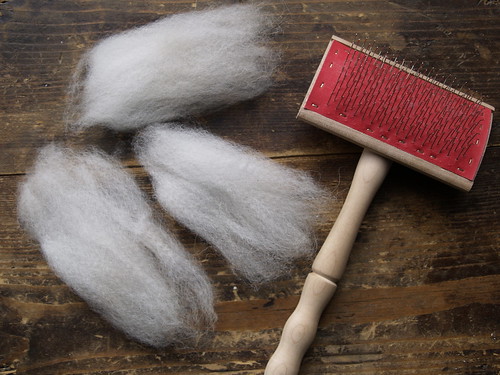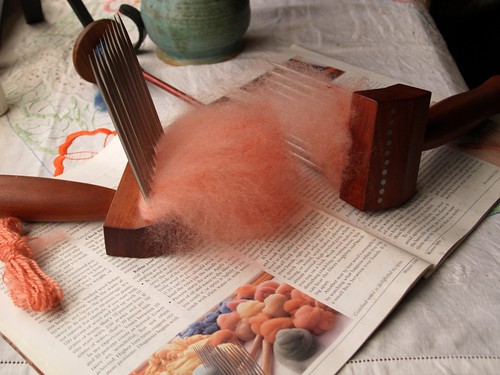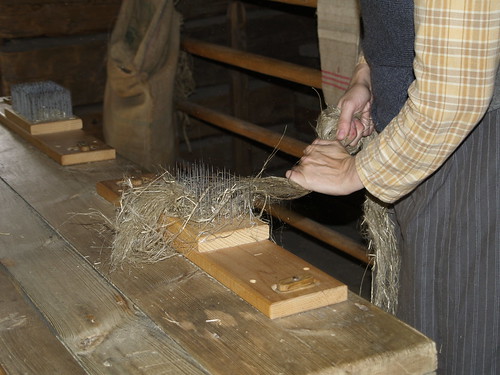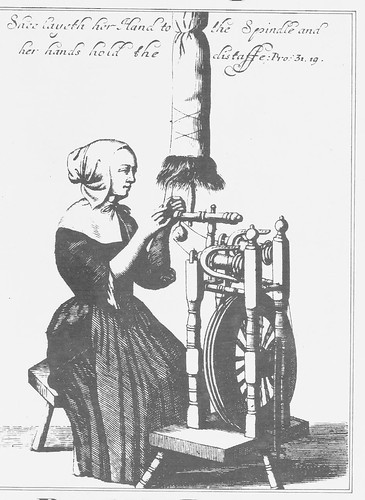A common question that new spinners ask me is “What else do I need to be able to spin?” If you are spinnng, you already have a spindle or wheel, and some fibre, and this is really all you need - the bare essentials, and you can spin happily for years without getting anything else. But there is also a load of other equipment out there that could make your spinning experience more varied, more enjoyable, or a faster process. Today I’ll give you a run-down of some spinning tools and accessories, and explain briefly what they are used for.
Carders or Hand-cards
This is often one of the first extra pieces of equipment that a new spinner buys. Carders are oblong pieces of wood with a handle, and are covered on one side with carding cloth, which has little steel teeth that trap the fibres. They are used as a pair and can be flat-backed or curved. Carded fibres are rolled up into rolags and are used to spin woolen yarns, or can be rolled so the fibres are parallel to spin a semi-worsted yarn.
Carders are almost essential if you are working with unprocessed fleece (it is possible to spin a good fleece without them if you tease the locks out with your fingers), and are very handy for blending fibres together. They come in a couple of different sizes - it’s best to get the larger ones as the size of the carders limits the length of the fibre you can use them with. Carders are also available in range of grades - finer fibres call for finer, more closely-set teeth.
Flick-carder
A flick-carder is used on its own and is much smaller than a carder, and covered with a similar carding cloth. It is used to open out fibres in a lock of wool, this can then be carded more easily, or spun directly from the opened-out lock. There is a great article on flick-carders in the Summer 2008 issue of Spin-Off. A dog comb, not to be confused with wool combs (below), is another handy tool which can be used to the same purpose as a flick carder.
Drum Carder
A drum carder is essentially a much larger version of a pair of hand cards, having two or more cylindrical barrels covered in carding cloth. It does the same job, but much more quickly, and produces large batts of airy, carded fibre. Visit Vampy’s blog for some fantastic tutorials on drum carding.
Wool Combs
These murderous-looking tools are used to produce combed top for true worsted spinning. They consist of a wooden base and handle, with one or more rows of long, sharp tines at a right angle. They are used in pairs, often with one clamped to a table. (The combs in this picture are of the smallest size, with only one row of tines.)
They are lovely for long fibres, and the resulting prep is fabulous to spin, although takes a bit more work than carding or flicking. Wool combs are often used in conjunction with a diz, a small concave tool with a hole in it through which the fibres are drawn off to create a continous length of combed top.
Hackle
A hackle is built with tines like those on wool combs, but is much wider. It is used for blending fibres, which can be drawn off with a diz into combed top. You can see a hackle being used to blend colours and fibres in this video. Hackling is also an essential part of the process in preparing flax for spinning. The flax fibres are drawn through the hackle many times to soften and separate them, and to strip away any woody bark.
Niddy Noddy
All handspun yarn will benefit from being wound into a skein and finished with steam or a nice bath. You can wind skeins around chairlegs, your arms or a large box, but it is quite a lot easier with a niddy noddy. Two arms sit perpendicular to each other and are joined by a shaft in the middle. The yarn is wound up and down over the arms in a long loop. A mini niddy noddy is handy for sample skeins.
Lazy Kate
Many wheels come with a Lazy Kate, somtimes built in as part of the wheel. The construction varies, all you need is rods to hold your bobbins or spindle cops, fixed to some sort of base. You can quickly improvise a Lazy Kate from a shoe-box and knitting needles, or there is a huge choice available to buy.
Tensioned Lazy Kates are very popular - they are fitted with a band (similar to a scotch tension band) which goes around the bobbins and attaches to an adjustable knob. Tensioning the bobbins stops them from free-spinning when you pull the singles off as you ply. This can lead to tangles in the singles or uneven plying.
Distaff
Distaff attachments are available for several models of spinning wheels, and can also be free-standing. The distaff is a post to which the fibre mass is attached, making it easy to draw off fibres as you spin. It is necessary when using extremely long fibres such as flax, and is also handy if you have a large, unmanageable mass of any fibre. Spindle spinners sometimes use small distaffs either hanging from the wrist or stuck into the belt, keeping the fibre tidy should they need to walk around while spinning.
- - - -
Anything I’ve forgotten? I’ll add more if I think of things, or feel free to request!
Please come by Lingr tonight for a chat - I’m not sure when I’ll be around, but definitely by 8.30 and most probably earlier.








 Entries (RSS)
Entries (RSS)